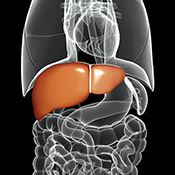Research Team Discovers Potential Treatment for Inherited Liver Disease
Opening up a can of worms is a good way to start hunting for new drugs, according to researchers from the University of Pittsburgh School of Medicine and Children’s Hospital of Pittsburgh of UPMC. A study published recently in the Public Library of Science One describes how the researchers employed a primitive worm model to discover that a drug used in schizophrenia could be used to treat severe liver scarring.
up a can of worms is a good way to start hunting for new drugs, according to researchers from the University of Pittsburgh School of Medicine and Children’s Hospital of Pittsburgh of UPMC. A study published recently in the Public Library of Science One describes how the researchers employed a primitive worm model to discover that a drug used in schizophrenia could be used to treat severe liver scarring.
Researchers found that fluphenazine, a drug typically used to treat agitation in schizophrenia and dementia, could potentially be used to treat an inherited disease,
-1 antitrypsin (AT) deficiency, which causes severe liver scarring.
In the classic form of AT deficiency, which affects 1 in 3,000 live births, a gene mutation leads to production of an abnormal protein, dubbed ATZ. Unlike its normal counterpart, ATZ is prone to clumping, explained David H. Perlmutter, Distinguished Professor and Vira I. Heinz Endowed Chair, Department of Pediatrics, Pitt School of Medicine.
“These protein aggregates accumulate in liver cells and eventually lead to scarring of the organ or to tumor formation,” said Perlmutter, who also is physician-in-chief and scientific director, Children’s Hospital of UPMC. “If we could find a drug that slows or stops this process, we might be able to prevent the need for liver transplantation in these patients.”
To find that drug, Perlmutter’s team worked with Pitt’s Stephen Pak, assistant professor of pediatrics, and Gary Silverman, Twenty-Five Club Professor of Pediatrics, Cell Biology and Physiology, who developed a model of AT deficiency in Caenorhabditis elegans, or C. elegans, a harmless microscopic worm or nematode typically found in soil.
find that drug, Perlmutter’s team worked with Pitt’s Stephen Pak, assistant professor of pediatrics, and Gary Silverman, Twenty-Five Club Professor of Pediatrics, Cell Biology and Physiology, who developed a model of AT deficiency in Caenorhabditis elegans, or C. elegans, a harmless microscopic worm or nematode typically found in soil.
Previous experiments conducted by Pak and Silverman, in which more than 2,000 compounds were screened, showed that fluphenazine, a drug approved for human use as a mood stabilizer, could reduce ATZ accumulation in the worm, so the team studied it further.
Worms that produce ATZ die sooner than normal ones, which typically have a life span of fewer than 20 days. Those that were exposed to fluphenazine, however, had lower burdens of ATZ and lived more than a day longer than untreated animals. The life span of normal worms was unchanged by fluphenazine exposure. The researchers also labeled with fluorescent markers intracellular structures called autophagosomes, which help clear abnormal proteins out of the cell in a process called autophagy. Fluphenazine exposure was associated with a greater presence of autophagosomes, suggesting that increased autophagy led to reduced ATZ accumulation.
Follow-up experiments showed that fluphenazine reduced ATZ accumulation in several mammalian-cell line models of AT deficiency, Silverman said.
“We found when we gave this drug for three weeks to mice with the disease, autophagy is activated, the abnormal protein load is diminished, and liver scarring is reversed. It’s truly amazing,” he said. “And because fluphenazine is already being safely prescribed for other conditions, it should be easier to bring it to clinical trials for AT deficiency.”
The project also reveals the power of the worm model to rapidly screen drug candidates, Perlmutter noted.
“This is the first extensive investigation of a drug that was discovered through the C. elegans screening method,” he said. “It’s remarkable that you can take a completely unbiased, high-content screen using a primitive organism and end up identifying a drug that reduces the accumulation of an abnormal protein in mammalian cell lines and a living mouse. It’s proof-of-principle of this research pipeline.”
Other coauthors of the paper include Jie Li, Linda P. O’Reilly, Joshua A. Benson, Yan Wang, Tunda Hidvegi, Pamela Hale, Christine Dippold, and Michael Ewing, all of Pitt’s School of Medicine and Children’s Hospital of Pittsburgh.
Other Stories From This Issue
On the Freedom Road

Follow a group of Pitt students on the Returning to the Roots of Civil Rights bus tour, a nine-day, 2,300-mile journey crisscrossing five states.
Day 1: The Awakening
Day 2: Deep Impressions
Day 3: Music, Montgomery, and More
Day 4: Looking Back, Looking Forward
Day 5: Learning to Remember
Day 6: The Mountaintop
Day 7: Slavery and Beyond
Day 8: Lessons to Bring Home
Day 9: Final Lessons

